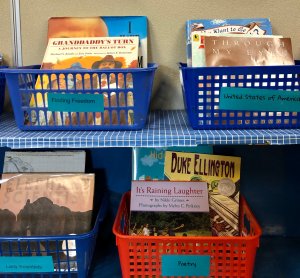A Class Library That Represents All Students
Simple ways to ensure that all students find stories that reflect their families, cultures, and experiences in your classroom library.
Like many elementary teachers, I spend a great deal of time organizing and reorganizing my classroom library. While tackling the job before this school year started, I took an informal assessment of whether or not the books in my color-coded baskets truly reflected the students who would soon populate my classroom. Unfortunately, they didn’t, so I told my family I’d be home late and set about overhauling my selection.
A good classroom library is full of books that students want to read. But a classroom library should also be a place where all students can readily find books that reflect their own families, cultures, and experiences. In this way, intentionally curating a diverse classroom library is an essential and meaningful step teachers can take to be inclusive.
Recent research suggests that between 70 and 80 percent of characters in children’s books are white. Less than 10 percent are African American, less than 2.5 percent are Latinx, and less than 1 percent are Native American. Moreover, most children’s book characters are male—of the 69 Caldecott Medal winners since 2000, only four were about female characters.
These numbers were clearly evident in my own library. The majority of characters that students encountered while reading in my class were white males. When the majority of books represent such narrow demographics, we should consider what messages we’re reinforcing.
It’s encouraging that increased awareness and activism seem to be shifting this representational imbalance. As a result, teachers have more opportunity to reimagine their libraries to be places that not only inspire wonder but also promote equity.
Increasing Diversity in Your Classroom Library
Setting up such a library takes time, volition, and perhaps a dose of caffeine, but it’s well worth doing. I’ve found useful book lists for increasing diversity at Here Wee Read, Brightly, NCTE, Social Justice Books, and Stories for All Project, and I list some of my favorites below.

It really helps to de-clutter your library to make room for new books. If no one is going to read a book, get rid of it. One year, I had a few student volunteers help me sort through a pile of maybes by telling me if kids would read them or not—if the pages were yellow or smelled musty, or if a cover looked old, kids wouldn’t read that book.
Here are few tips to ensure that your library is easy to use and reminds students of all backgrounds that their lives are more than worth writing and reading about.
Do an inventory. How many of your books:
- feature people of color as the central character, rather than a sidekick?
- feature LGBTQ and gender expansive characters?
- feature Native Americans?
- feature characters with intellectual disabilities?
- feature characters who are not lanky, scrappy, skinny, or small?
- treat incarcerated characters with dignity?
- are written by an author of color?
- challenge harmful social norms?
Encourage social stretch books. Elementary teachers often suggest that students read “reach” books that nudge them toward higher reading levels. We can also encourage them to read texts that stretch their cultural awareness and comfort zones.
Feature timely and relevant social issues. Some ideas: American Elections, Women in Science, Climate Change, The Road to Freedom and Social Justice, Characters Who Stay True to Themselves, Struggling Against Hate, Human Rights, Athlete-Activists.
Be in the conversation. Who are you following on social media? Make sure your feeds are informed with diverse perspectives and forward thinking individuals. For example, try following these people on Twitter: @Jess5th, @MisterMinor, @guerrette79, @juliaerin80, and @betweenmargins. They share great texts, ideas, and insights on using literature purposefully in the classroom.
Providing students with an abundance of diverse books is a critical step in ensuring that every student feels visible. However, it’s equally important that teachers support this work by teaching students to evaluate texts not solely on the traditional standards of story elements and author’s craft—students can and should learn to consider who is in the texts, and what implicit and explicit biases are either supported or dispelled through these characters.
An intentionally curated classroom library means that a teacher is purposefully making decisions based on equity and human worth.
My Favorite Texts for Middle Grades
The Red Pencil by Andrea Davis Pinkney
Full Cicada Moon by Marilyn Hilton
Ghost by Jason Reynolds
I’m OK by Patti Kim
Witch Boy by Molly Knox Ostertag
The House That Lou Built by Mae Respicio
Forget Me Not by Ellie Terry
Shooting Kabul by N.H. Senzai
Save Me a Seat Sarah Weeks and Gita Varadarajan
Rain Reign by Ann M. Martin
It Ain’t So Awful, Falafel by Firoozeh Dumas
The Crossover by Kwame Alexander
Amal Unbound by Aisha Saeed
Where the Mountain Meets the Moon by Grace Lin
The Pants Project by Cat Clarke
Amina’s Voice by Hena Khan
Wishtree by Katherine Applegate
Pashmina by Nidhi Chanani
Ivy Aberdeen’s Letter to the World by Ashley Herring Blake
How I Became a Ghost by Tim Tingle
Trickster: Native American Tales, A Graphic Collection by Matt Dembicki
Us, in Progress: Short Stories About Young Latinos by Lulu Delacre
Secret Coders (series) by Gene Luen Yang and Mike Holmes
Nelson Beats the Odds by Ronnie Sidney II and Tiffany Carey Day
